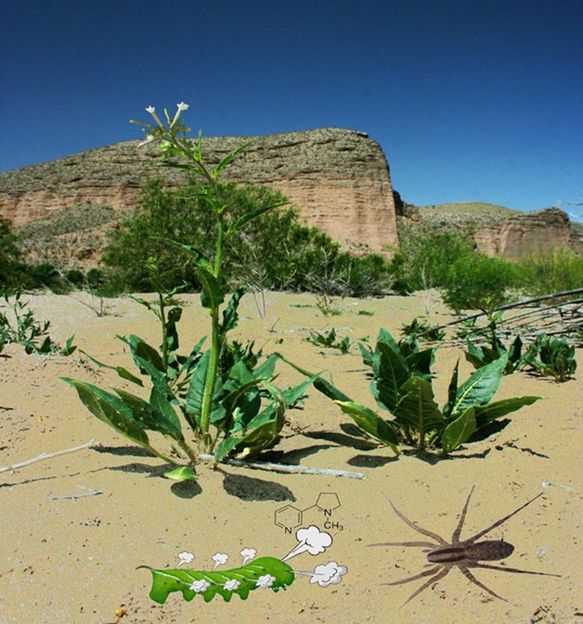Toxic breath keeps spiders away
Tobacco hornworm larvae exhale a small fraction of nicotine from ingested tobacco leaves as a defense signal to deter predatory spiders
Caterpillars use different strategies to protect themselves from their enemies; many are camouflaged, while others use their bright colors as warning signals, have stinging hairs or secrete toxic substances, some even take threatening postures. Scientists at the Max Planck Institute for Chemical Ecology have now discovered a previously unknown protective mechanism: tobacco hornworm larvae can exhale a small fraction of nicotine they ingest as they feed on tobacco leaves. To do so, they transfer some of the nicotine they ingest into their hemolymph (insect blood) from which a “defensive halitosis” is created that repels a major predator. These insights were made possible by combining molecular techniques with a natural history approach in field experiments in the native habitat of the study organisms.

Interaction between the caterpillar Manduca sexta and the spider Camptocosa parallela. The caterpillars nicotin breath frigthens the spider.
Danny Kessler; Grafiken: Pavan Kumar und Sagar Pandit, MPI Chem. Ökol.

Spider Camptocosa parallela attacks a caterpillar.
Pavan Kumar, MPI chem. Ökol.


The importance of the ecosystem for studying gene functions
Understanding the function of genes is a central objective of biological research. Ultimately, genes function at the level of the organism, where their influence on an organism’s Darwinian fitness determines whether a gene is retained, modified or lost from genomes over evolutionary time. Gene silencing is a successful research method used to identify the function of individual genes and their relevance for the survival and fitness of an organism. In addition to a gene’s biochemical and physiological roles that can be studied in the laboratory, the ecological role of a gene needs to be studied, and for this, there can be no better laboratory than the organism’s natural habitat. Scientists from the Department of Molecular Ecology headed by Ian Baldwin pioneer this approach and call it an unbiased, “ask the ecosystem” approach. “Nature is our most important teacher,” Ian Baldwin emphasizes. “Nature is the arbitrator of who survives. Elucidation of gene functions is only possible if you study organisms in their native environment − including all the unknowns of the wild.”
For their field experiments, researchers planted tobacco plants that were deficient in producing nicotine. In addition, they used a plant-mediated RNAi technique to silence a cytochrome P450 enzyme in the midgut of tobacco hornworm larvae (see press release “Yellow Biotechnology: Using plants to silence insect genes in a high-throughput manner”, February 2, 2012) which is usually activated by nicotine ingested when the larvae feed on tobacco leaves. The scientists then observed what happened to caterpillars feeding on nicotine-deficient plants in order to compare their fate with those caterpillars that had ingested nicotine but lacked the active catalyzer for the toxin in their midgut.
Predatory spider assists the process of elucidating a defense mechanism
The function of the cytochrome P450 proved hard to reveal by laboratory-based experiments, but then the researchers received unexpected support from a wolf spider Camptocosa parallela. Surprisingly, the nocturnal predator preferably preyed not only on larvae that fed on nicotine-free leaves, but also preyed on their cytochrome P450-silenced conspecifics that were deficient in their response to nicotine in the food. The gene must therefore have played an important role in a spider defense mechanism that usually excludes the spider from the list of Manduca sexta’s enemies.
Further analysis revealed that the enzyme plays a role in transporting the ingested nicotine from midgut to the hemolymph which allows the nicotine to be exhaled out the spiracles, the nose-equivalents of the caterpillars. Caterpillars exhale a small fraction of this nicotine. And this functions as an anti-spider signal. Other predators of Manduca sexta, such as bugs or antlions, seem to be completely insensitive to this defensive halitosis.
Nicotine, the defensive substance in their host plant, is too toxic for the larvae to sequester. Most of it is excreted. That the larvae repurposes only a tiny amount of the toxin for their own defense in order to ward off spiders with a kind of toxic halitosis came as a surprise for the scientists. “This case of toxic breath as a defense is unique,” says Ian Baldwin. The example of the wolf spider illustrates the importance of combining molecular biology and natural history to understand the function of genes at the level of the organism.



















































